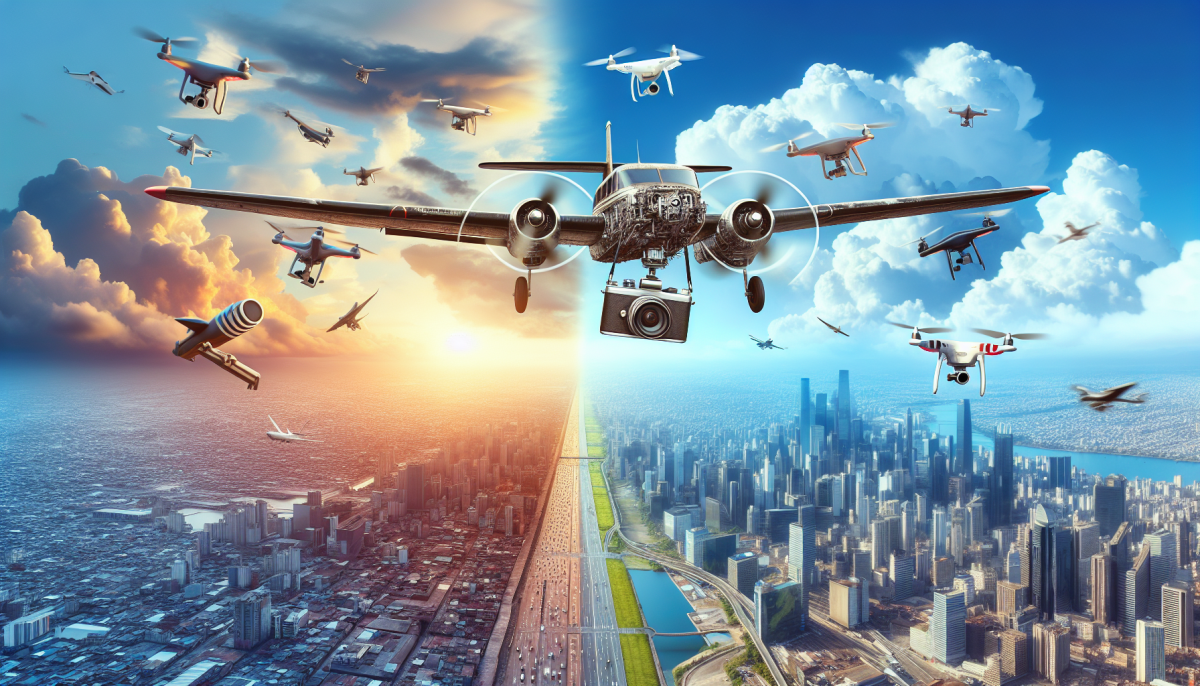Drones have changed aerial photography a lot. Now, 95% of the photos we take from the sky are done with drones. This change is big because drones can fly longer, have better GPS, and take pictures that are just as good as cameras on the ground.
Photographers can do more and be more creative with better batteries and faster drones. We're looking at how these new tools make aerial photography better, showing us the world with more detail than ever before.
Key Takeaways
- Advancements in drone technology have revolutionized remote controls and flight enhancements, allowing for precise maneuverability and longer flight times.
- GPS navigation has significantly improved operational efficiency in aerial photography by enabling accurate path following, mapping, and automated flight routes.
- Integrating GPS navigation and advanced pathfinding algorithms has enhanced safety and obstacle detection in drone flights.
- Improved camera quality, including higher megapixel counts, sensor sensitivity, and stabilization technology, has resulted in crisper and more detailed images, even in challenging conditions.
Remote Control Evolution
We've observed how drone technology advancements have revolutionized remote controls' capabilities in aerial photography.
Modern drones leverage cutting-edge radio advancements to extend control range, ensuring precise maneuverability over vast distances. This increased range isn't just about distance; it's about the robustness of the signal, which now contends with fewer interferences and offers greater reliability.
We're talking about a quantum leap from the rudimentary radio controllers of the past to sophisticated systems that harness advanced frequencies and modulation techniques. These improvements allow us to capture high-resolution images from previously inaccessible vantage points, opening up a realm of possibilities for innovation in various fields.
The technical evolution of drone remote controls has undoubtedly expanded our horizons in aerial photography.
Flight Time Enhancement
Better batteries have really made a difference for drones. Now they can fly longer without stopping, which is great for taking more pictures from the sky or for watching an area for a long time. This means photographers and businesses can get a lot more useful information from up high.
For instance, a real estate photographer can now use a drone like the DJI Mavic Air 2, which boasts a flight time of up to 34 minutes, to take a full set of high-quality images of a property without the need to land and change batteries multiple times. This is a big step forward because it makes the work quicker and gives better results.
Extended Battery Life
Our exploration of drone technology's impact on aerial photography wouldn't be complete without acknowledging how extended battery life has significantly increased flight times. We've seen advancements in battery maintenance and the development of sophisticated charging infrastructure that together enhance operational efficiency. This is critical for photographers who require prolonged periods of flight to capture the perfect shot.
Here's a detailed look at the current landscape:
| Aspect | Innovation | Benefit |
|---|---|---|
| Battery Composition | Increased energy density materials | Longer flights without additional weight |
| Charging Technology | Fast-charging systems | Reduced downtime between flights |
| Power Management | Smart systems that optimize energy use | Extended operational time |
| Design Integration | Batteries shaped to fit drone's design | Better aerodynamics and flight stability |
| Maintenance | Advanced battery health monitoring | Increased battery lifespan and reliability |
Our technical analysis shows that these enhancements are pivotal in pushing the boundaries of aerial photography.
Improved Operational Efficiency
Building on the advancements in battery technology, we're now witnessing drones with enhanced operational efficiency, which translates directly into longer, more productive flight times for aerial photography. This progression yields several key benefits:
-
Extended Missions: Longer flight times allow for more comprehensive data collection in a single sortie.
-
Cost Reduction: Minimized need for multiple take-offs and landings, which conserves resources and reduces operational costs.
-
Risk Mitigation: Fewer landings and take-offs mean less exposure to potential accidents or mishaps.
-
Enhanced Data Quality: Sustained airtime enables more detailed, high-resolution imaging sequences.
-
Operational Flexibility: Pilots can adapt to changing conditions without the pressure of limited battery life.
With these improvements, we're strategically elevating the standards of aerial photography, ensuring precision and efficacy in every flight.
Longer Surveillance Duration
Frequently, we observe that drones equipped with longer-lasting batteries provide significantly extended surveillance durations, revolutionizing the scope of aerial photography missions. These enhancements are a direct result of relentless innovation in power efficiency and battery technology. We now deploy drones capable of enduring extended flights, which is crucial for comprehensive site surveys, environmental monitoring, and security operations.
Incorporating weather resistance into drone design has similarly been pivotal. Drones can withstand diverse climatic conditions, ensuring reliability in prolonged missions. Moreover, advancements in night vision capabilities allow for uninterrupted surveillance, even in low-light scenarios. This ensures that aerial photography isn't restricted by the time of day, opening up new possibilities for continuous observation and data gathering.
Our analytical approach to these technological leaps ensures we remain at the forefront of capturing transformative aerial imagery.
GPS Navigation Significance
GPS technology has really changed how drones take pictures from the air. Using GPS, drones can follow a set path very accurately, which means they can take the same pictures repeatedly without mistakes. This is important because it makes the whole process easier and there's less chance of messing up when collecting important information.
For example, a drone with GPS can be used to map out a construction site by flying the same route every day, which helps keep track of progress without errors. This method is more efficient and saves time because it's all programmed and automatic.
Enhanced Flight Precision
Our exploration of aerial photography's evolution reveals that GPS technology has significantly sharpened drones' flight precision, enabling pinpoint accuracy in image capture. Flight accuracy and precision control aren't merely buzzwords but cornerstones of advanced aerial imaging. Let's delve into the technicalities that showcase this transformation:
-
Geotagging Capabilities: By embedding precise coordinates, drones catalog images with exact location data.
-
Stabilized Flight Paths: GPS facilitates steady routes, mitigating drift and enhancing frame consistency.
-
Automated Flight Patterns: Pre-programmed waypoints ensure comprehensive area coverage without manual piloting errors.
-
Real-Time Corrections: GPS feedback allows drones to adjust to environmental factors, maintaining designated coordinates.
-
Return-to-Home Functions: A failsafe that relies on GPS to guide drones back to a predefined location, safeguarding equipment and data.
This GPS-driven precision is pivotal for disciplines demanding meticulousness, from cartography to construction.
Automated Pathfinding Benefits
As aerial photographers, we've witnessed a remarkable shift in the landscape of our craft, as the integration of GPS navigation into drones has unlocked numerous pathfinding benefits. This advancement enables us to execute complex flight plans with a once unattainable precision. Path optimization has become a cornerstone of aerial photography, allowing for meticulous planning and execution of flight paths to capture the perfect angles and images.
Moreover, incorporating collision avoidance systems guided by GPS, has significantly reduced the risks associated with aerial navigation. Drones can now autonomously detect and maneuver around obstacles, ensuring the equipment's safety and the footage's integrity.
This synergy of GPS navigation with advanced pathfinding algorithms exemplifies the tremendous strides we've made in elevating the quality and safety of aerial photography.
Camera Quality Advancements
In the realm of drone technology, camera quality advancements have significantly enhanced aerial photography's capabilities and outcomes. Sensor upgrades and stabilization technology are at the forefront of this transformation.
We've witnessed increased megapixel counts, allowing for crisper images with higher resolution. This improvement in camera quality has resulted in unprecedented levels of detail and clarity in aerial images. We're now capturing once-impossible perspectives, propelling aerial photography into a new era of innovation and artistic expression.
Improved sensor sensitivity is another key factor in the advancement of aerial photography. This boost in sensitivity enhances low-light performance, making capturing stunning images during dawn and dusk shoots possible. The ability to capture clear images in challenging lighting greatly expands photographers' possibilities.
Enhanced dynamic range is another benefit of drone camera technology advancements. Drones can capture more detail in shadows and highlights with improved dynamic range. This means aerial photographers can capture a wider range of tones and colors, creating more visually striking and dynamic images.
Advanced stabilization technology is also worth noting. With this technology, drones can capture ultra-smooth footage even in challenging conditions. This means aerial videographers can capture stunning videos without the jerkiness typically associated with drone footage.
Lastly, integrating optical and digital zoom features in drone cameras is a significant development. This integration allows photographers to zoom in on subjects without compromising image quality. This means aerial photographers can capture detailed shots from a distance, creating new possibilities for capturing unique and captivating images.
Drone Speed Impact
Building on the remarkable improvements in camera technology, we've also seen how increased drone speeds have broadened the possibilities for capturing fast-paced events from above. High-velocity drones can now keep pace with speeding vehicles, athletic competitions, and wildlife, ensuring the resultant footage is dynamic and engaging. The upsurge in speed capabilities goes hand in hand with advancements in gyro-stabilization systems, which are crucial for maintaining the camera's focus and delivering sharper images even at high velocities.
Moreover, drones with better low light performance can exploit their speed to maximize available light, mitigating motion blur typically associated with evening or dawn shoots. This fusion of speed and sensitivity allows us to push the boundaries of aerial photography, achieving crisp, clear images in conditions once considered too challenging.
Battery Capacity Importance
Beyond enhancing speed and camera stability, we've also benefited from significant increases in drone battery life, which allow us to extend our aerial photography sessions and capture more footage without the interruption of frequent recharging.
The implications of this advancement are multifaceted:
-
Longer Flight Times: We can undertake prolonged missions with improved battery capacity, enabling comprehensive surveying and detailed landscape captures.
-
Reduced Downtime: Enhanced battery life minimizes the need for mid-operation swaps, streamlining the workflow.
-
Advanced Charging Infrastructure: We're seeing the development of rapid charging stations and portable charging solutions, bolstering efficiency in the field.
-
Sustainability: Innovations in battery technology include more eco-friendly options and improved battery disposal mechanisms, reducing environmental impact.
-
Economic Benefits: Fewer batteries are needed per operation, lower long-term costs and resource consumption.
Our Final Thoughts On Aerial Photography
Drone technology has greatly improved aerial photography. Thanks to better batteries, Drones can fly longer, higher up with the birds.
They use GPS to fly very accurately. The cameras on drones are also much better, taking very clear and detailed pictures from above.
These improvements in speed and power have pushed aerial photography to new levels. It's like we've turned technology into an art, always finding new ways to capture images from the sky.
Discover our collection of gadgets designed specifically for men and find the perfect gift for your special someone.



